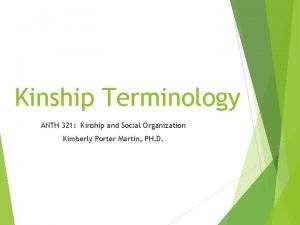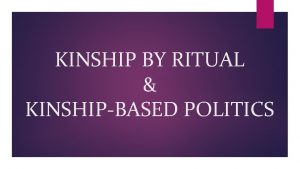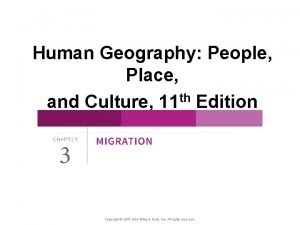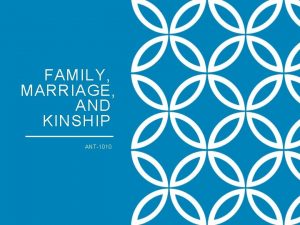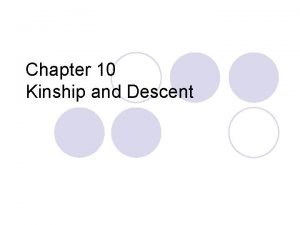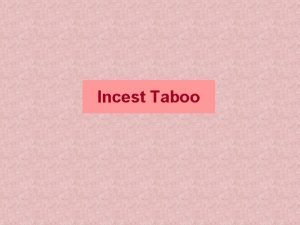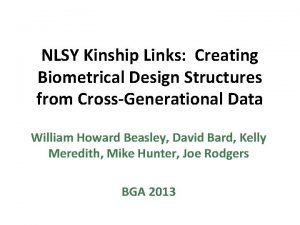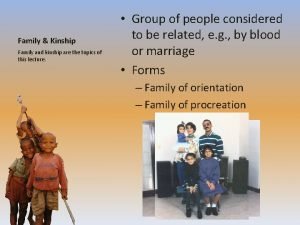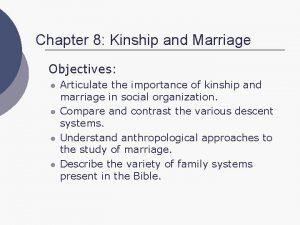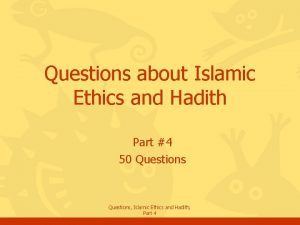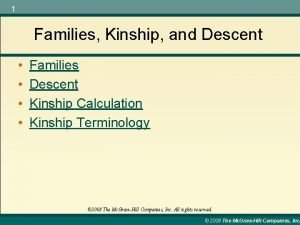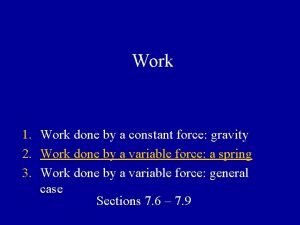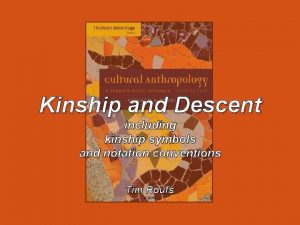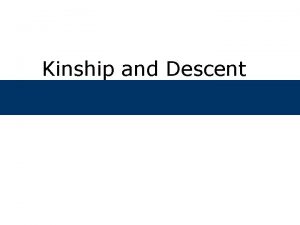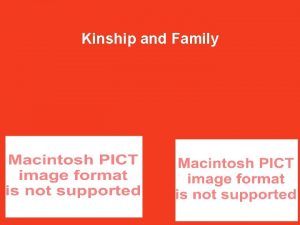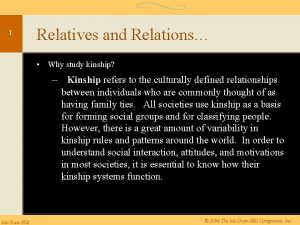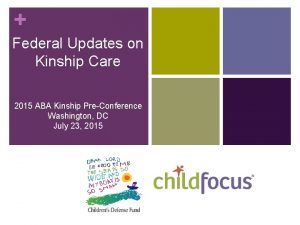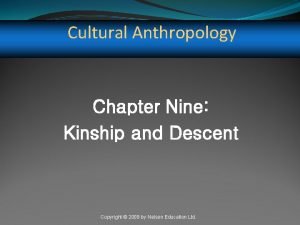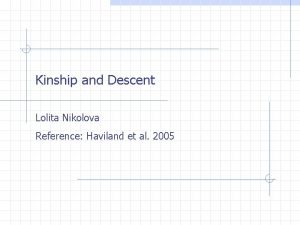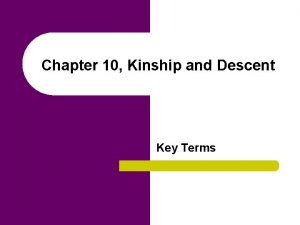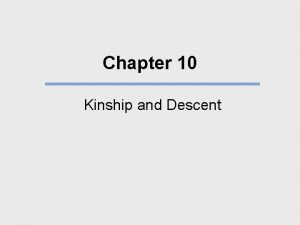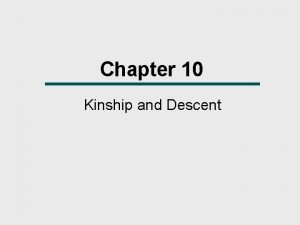Kinship and Descent Unit 4 A What is



















- Slides: 19

Kinship and Descent Unit 4 A

What is Kinship? • Kinship – relationships based on blood or marriage • Every society defines the nature of kinship interaction by determining – which kin are more socially important than others, – terms to classify kin types, – expected forms of behavior between them • Fictive kinship – people who are not related by blood or marriage • Consanguineal kin – kinship based on bloodline • Affinal kin – kinship based on marriage

Cultural Rules Regarding Kinship • All kinship systems are founded on biological connections – Each society classifies its kin according to a set of cultural rules that may or may not account for biological factors – The ways in which societies sort and categorize kinship relationships is as much a matter of culture as it is a matter of biology

Functions of Kinship Systems • Vertical function – provides social continuity by binding together a number of successive generations • Horizontal function – tend to solidify or tie together a society across a single generation through the process of marriage

Descent Groups • Kinship systems encompass all the blood and marriage relationships that – Distinguish among different categories of kin – Create rights and obligations among kin – Serve as the basis for the formation of certain types of kin groups • The rules a culture uses to establish affiliations with one’s parents and ancestors • Often provide the basis for the formation of social groups

Descent Groups cont’d • In societies with descent groups (unilineal or cognatic), members: – Have a strong sense of identity – Often share communally held property – Provide economic assistance to one another – Engage in mutual civic and religious ceremonies – Serve as a social and political mechanism for • • Inheriting property and political office Controlling behavior Regulating marriages Structuring primary political units

Unilineal Descent Groups • Approximately 60% of all kinship systems • Trace descent through either mother’s or father’s line, but not both • Mother’s line = matrilineal descent • Father’s line = patrilineal descent

Patrilineal Descent • Found on all continents and a wide range of societies • Most common unilineal descent system • Females marry outside the patrilineage and their children belong to the father’s descent line • Example = traditional Chinese culture (patrilineal, patrilocal, obligations to elders)

Matrilineal Descent • Matrilineal descent group comprised of a woman, her siblings, her own children, her sisters’ children, and her daughters’ children • Make up about 15% of unilineal descent groups in contemporary societies • Different from matriarchy (mythological) • Men retain power and authority but inherit it through the women • Example = Zuni of New Mexico

Types of Unilineal Descent • Four major types in increasing levels of inclusiveness: lineages, clans, phratries, moieties

Unilineal Descent: Lineages • Unilineal descent groups of up to approximately 10 generations in depth • Members can trace their ancestry back (step by step) to a common founder (matrilineages or patrilineages) • Can undergo segmentation – subdivision into smaller units depending on social situation

Unilineal Descent: Clans • A group of kin usually comprising 10 or more generations whose members believe they are all related to a common ancestor but are unable to trace their connections • When clans and lineages are found together, the clan is usually made up of a number of different lineages • Tend to be larger and more loosely structured categories with which people identify • Often associated with animals or plants (totems) that provide a focal point for group identity

Unilineal Descent: Phratries • Unilineal descent groups composed of two or more clans • Actual connections between the two clans usually are not recognized • Generally rare and do not serve important social functions

Unilineal Descent: Moieties • Societies that are divided into two unilineal descent groups • Excellent example of social reciprocity • Can play important roles in society but are not a part of the political structure as are lineages or clans

Corporate Nature of Unilineal Descent Groups • Clearly define who is a member and who is not • Endure over time • Shape a person’s identity • Regulate marriage • Regulate property, rather than individual control • Strong corporate focus in social control

Cognatic (nonunilineal) Descent Groups • Approximately 40% of world’s population • 3 basic types: – double descent, – ambilineal descent, – bilateral descent

Cognatic: Double Descent • Kinship is traced both matrilineally and patrilineally • Only about 5% of world’s cultures • Patrilineal groups and matrilineal groups are active in different spheres of the culture

Cognatic: Ambilineal Descent • Parents have a choice of affiliating their children with either kinship group • More flexible system – allows for individual choice concerning group affiliation • The greater the flexibility of choice concerning membership, the weaker thr group’s loyalties, cohesiveness, and impact on the lives of its members

Cognatic: Bilateral Descent • Person related equally to mother’s and father’s side of the family • Practiced in U. S. • Creates links from both sides of the family but usually include only close kin from a small number of generations • Kindred – closely related relatives connected through both parents to one living relative (or to EGO) • No two relatives (except siblings) have the same kindred • Loosely structured network of relatives works well in a society that highly values personal independence and geographic mobility
 Kinship terminology
Kinship terminology Kinship ritual
Kinship ritual Vertical function of kinship
Vertical function of kinship Gravity model ap human geography
Gravity model ap human geography Monomgamy
Monomgamy Classification of kinship
Classification of kinship Hawaiian kinship system
Hawaiian kinship system Biological kinship
Biological kinship Kinship links definition
Kinship links definition Kinship diagram symbols
Kinship diagram symbols Cross vs parallel cousins
Cross vs parallel cousins Propositional logic in ai ppt
Propositional logic in ai ppt Family quotes in islam
Family quotes in islam Strong affection
Strong affection Lineal kinship terminology
Lineal kinship terminology Texas descent and distribution before 1993
Texas descent and distribution before 1993 A c v waves jvp
A c v waves jvp Unit 10, unit 10 review tests, unit 10 general test
Unit 10, unit 10 review tests, unit 10 general test The work done by gravity during the descent of a projectile
The work done by gravity during the descent of a projectile Vda jeppesen
Vda jeppesen
